Financial Analysis Report: Fine Furnishings Performance Review
VerifiedAdded on 2023/04/21
|8
|1809
|429
Report
AI Summary
This report presents a financial analysis of Fine Furnishings, evaluating its performance based on balance sheet, income statement, and cash flow statement data. The analysis includes assessment of working capital, debt ratios, inventory turnover, and profitability metrics. The report highlights a decrease in revenues, reduction in inventory, and increased expenses, leading to a decline in gross profit. Despite a good current ratio and liquidity position, the report suggests that the company should invest in innovative products, increase advertising, and explore new markets to improve its financial standing and competitive position. The analysis also provides key ratios such as gross margin, profit margin, and asset efficiency ratio, which are used to assess the financial health of the company. The report concludes with recommendations for management to enhance revenues and improve the company's market position.
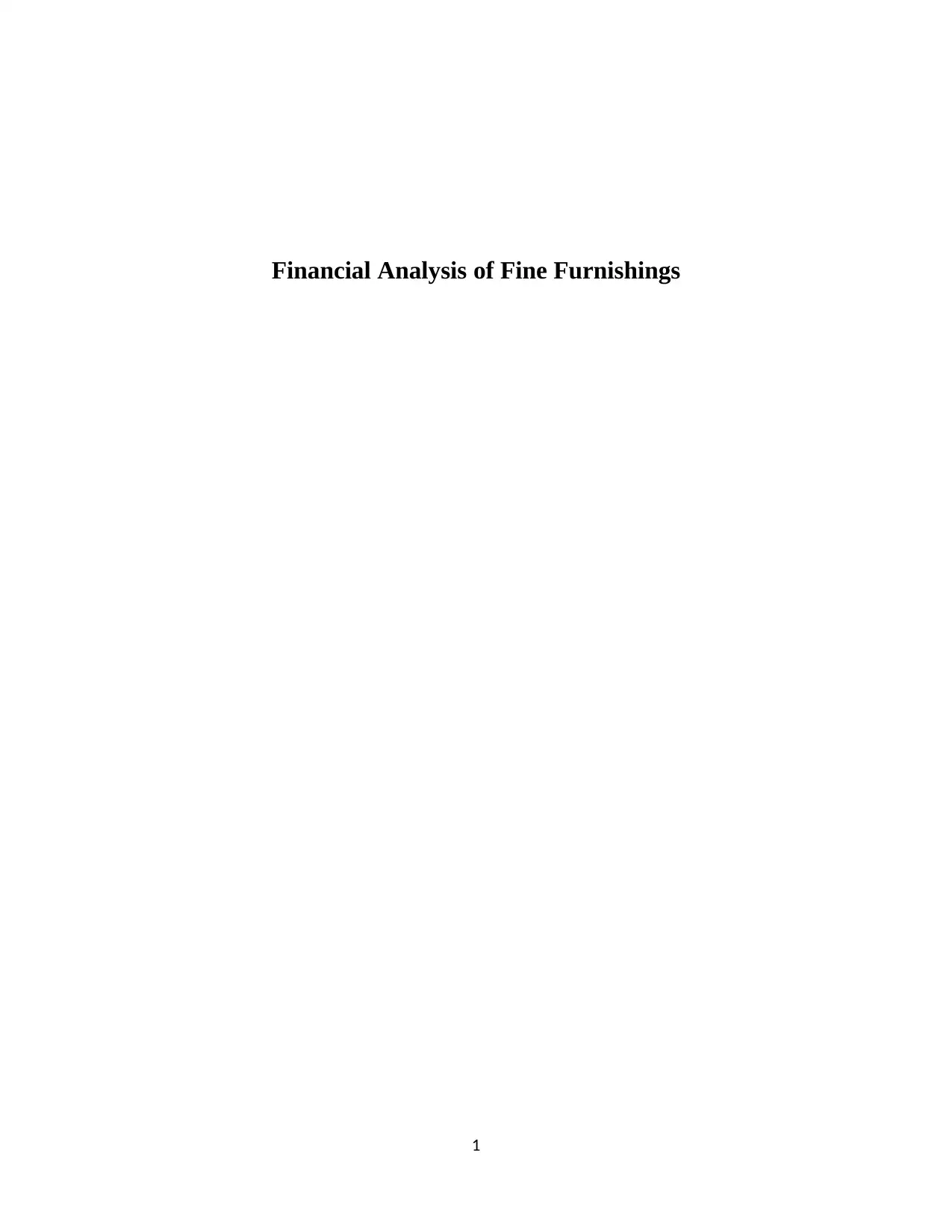
Financial Analysis of Fine Furnishings
1
1
Paraphrase This Document
Need a fresh take? Get an instant paraphrase of this document with our AI Paraphraser
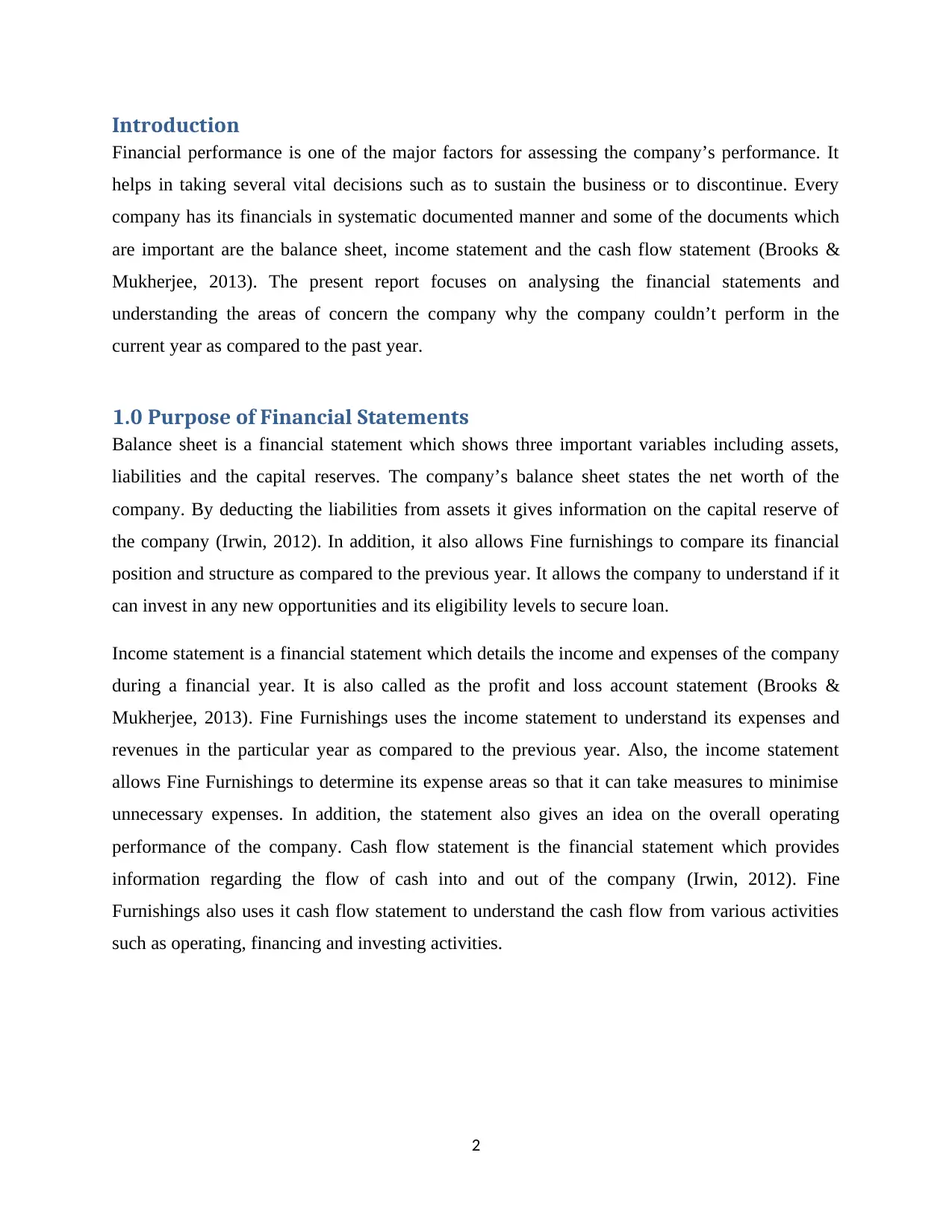
Introduction
Financial performance is one of the major factors for assessing the company’s performance. It
helps in taking several vital decisions such as to sustain the business or to discontinue. Every
company has its financials in systematic documented manner and some of the documents which
are important are the balance sheet, income statement and the cash flow statement (Brooks &
Mukherjee, 2013). The present report focuses on analysing the financial statements and
understanding the areas of concern the company why the company couldn’t perform in the
current year as compared to the past year.
1.0 Purpose of Financial Statements
Balance sheet is a financial statement which shows three important variables including assets,
liabilities and the capital reserves. The company’s balance sheet states the net worth of the
company. By deducting the liabilities from assets it gives information on the capital reserve of
the company (Irwin, 2012). In addition, it also allows Fine furnishings to compare its financial
position and structure as compared to the previous year. It allows the company to understand if it
can invest in any new opportunities and its eligibility levels to secure loan.
Income statement is a financial statement which details the income and expenses of the company
during a financial year. It is also called as the profit and loss account statement (Brooks &
Mukherjee, 2013). Fine Furnishings uses the income statement to understand its expenses and
revenues in the particular year as compared to the previous year. Also, the income statement
allows Fine Furnishings to determine its expense areas so that it can take measures to minimise
unnecessary expenses. In addition, the statement also gives an idea on the overall operating
performance of the company. Cash flow statement is the financial statement which provides
information regarding the flow of cash into and out of the company (Irwin, 2012). Fine
Furnishings also uses it cash flow statement to understand the cash flow from various activities
such as operating, financing and investing activities.
2
Financial performance is one of the major factors for assessing the company’s performance. It
helps in taking several vital decisions such as to sustain the business or to discontinue. Every
company has its financials in systematic documented manner and some of the documents which
are important are the balance sheet, income statement and the cash flow statement (Brooks &
Mukherjee, 2013). The present report focuses on analysing the financial statements and
understanding the areas of concern the company why the company couldn’t perform in the
current year as compared to the past year.
1.0 Purpose of Financial Statements
Balance sheet is a financial statement which shows three important variables including assets,
liabilities and the capital reserves. The company’s balance sheet states the net worth of the
company. By deducting the liabilities from assets it gives information on the capital reserve of
the company (Irwin, 2012). In addition, it also allows Fine furnishings to compare its financial
position and structure as compared to the previous year. It allows the company to understand if it
can invest in any new opportunities and its eligibility levels to secure loan.
Income statement is a financial statement which details the income and expenses of the company
during a financial year. It is also called as the profit and loss account statement (Brooks &
Mukherjee, 2013). Fine Furnishings uses the income statement to understand its expenses and
revenues in the particular year as compared to the previous year. Also, the income statement
allows Fine Furnishings to determine its expense areas so that it can take measures to minimise
unnecessary expenses. In addition, the statement also gives an idea on the overall operating
performance of the company. Cash flow statement is the financial statement which provides
information regarding the flow of cash into and out of the company (Irwin, 2012). Fine
Furnishings also uses it cash flow statement to understand the cash flow from various activities
such as operating, financing and investing activities.
2
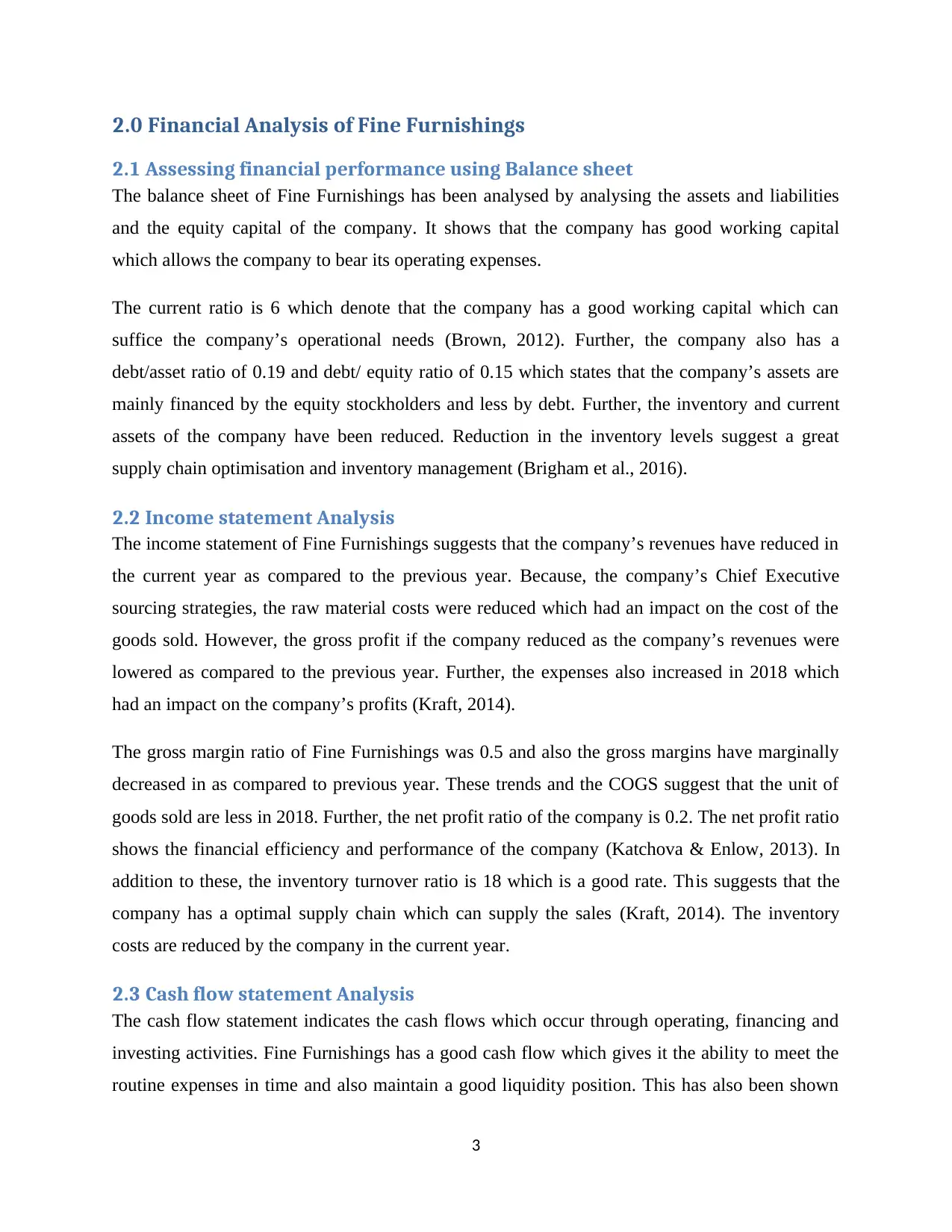
2.0 Financial Analysis of Fine Furnishings
2.1 Assessing financial performance using Balance sheet
The balance sheet of Fine Furnishings has been analysed by analysing the assets and liabilities
and the equity capital of the company. It shows that the company has good working capital
which allows the company to bear its operating expenses.
The current ratio is 6 which denote that the company has a good working capital which can
suffice the company’s operational needs (Brown, 2012). Further, the company also has a
debt/asset ratio of 0.19 and debt/ equity ratio of 0.15 which states that the company’s assets are
mainly financed by the equity stockholders and less by debt. Further, the inventory and current
assets of the company have been reduced. Reduction in the inventory levels suggest a great
supply chain optimisation and inventory management (Brigham et al., 2016).
2.2 Income statement Analysis
The income statement of Fine Furnishings suggests that the company’s revenues have reduced in
the current year as compared to the previous year. Because, the company’s Chief Executive
sourcing strategies, the raw material costs were reduced which had an impact on the cost of the
goods sold. However, the gross profit if the company reduced as the company’s revenues were
lowered as compared to the previous year. Further, the expenses also increased in 2018 which
had an impact on the company’s profits (Kraft, 2014).
The gross margin ratio of Fine Furnishings was 0.5 and also the gross margins have marginally
decreased in as compared to previous year. These trends and the COGS suggest that the unit of
goods sold are less in 2018. Further, the net profit ratio of the company is 0.2. The net profit ratio
shows the financial efficiency and performance of the company (Katchova & Enlow, 2013). In
addition to these, the inventory turnover ratio is 18 which is a good rate. This suggests that the
company has a optimal supply chain which can supply the sales (Kraft, 2014). The inventory
costs are reduced by the company in the current year.
2.3 Cash flow statement Analysis
The cash flow statement indicates the cash flows which occur through operating, financing and
investing activities. Fine Furnishings has a good cash flow which gives it the ability to meet the
routine expenses in time and also maintain a good liquidity position. This has also been shown
3
2.1 Assessing financial performance using Balance sheet
The balance sheet of Fine Furnishings has been analysed by analysing the assets and liabilities
and the equity capital of the company. It shows that the company has good working capital
which allows the company to bear its operating expenses.
The current ratio is 6 which denote that the company has a good working capital which can
suffice the company’s operational needs (Brown, 2012). Further, the company also has a
debt/asset ratio of 0.19 and debt/ equity ratio of 0.15 which states that the company’s assets are
mainly financed by the equity stockholders and less by debt. Further, the inventory and current
assets of the company have been reduced. Reduction in the inventory levels suggest a great
supply chain optimisation and inventory management (Brigham et al., 2016).
2.2 Income statement Analysis
The income statement of Fine Furnishings suggests that the company’s revenues have reduced in
the current year as compared to the previous year. Because, the company’s Chief Executive
sourcing strategies, the raw material costs were reduced which had an impact on the cost of the
goods sold. However, the gross profit if the company reduced as the company’s revenues were
lowered as compared to the previous year. Further, the expenses also increased in 2018 which
had an impact on the company’s profits (Kraft, 2014).
The gross margin ratio of Fine Furnishings was 0.5 and also the gross margins have marginally
decreased in as compared to previous year. These trends and the COGS suggest that the unit of
goods sold are less in 2018. Further, the net profit ratio of the company is 0.2. The net profit ratio
shows the financial efficiency and performance of the company (Katchova & Enlow, 2013). In
addition to these, the inventory turnover ratio is 18 which is a good rate. This suggests that the
company has a optimal supply chain which can supply the sales (Kraft, 2014). The inventory
costs are reduced by the company in the current year.
2.3 Cash flow statement Analysis
The cash flow statement indicates the cash flows which occur through operating, financing and
investing activities. Fine Furnishings has a good cash flow which gives it the ability to meet the
routine expenses in time and also maintain a good liquidity position. This has also been shown
3
⊘ This is a preview!⊘
Do you want full access?
Subscribe today to unlock all pages.

Trusted by 1+ million students worldwide
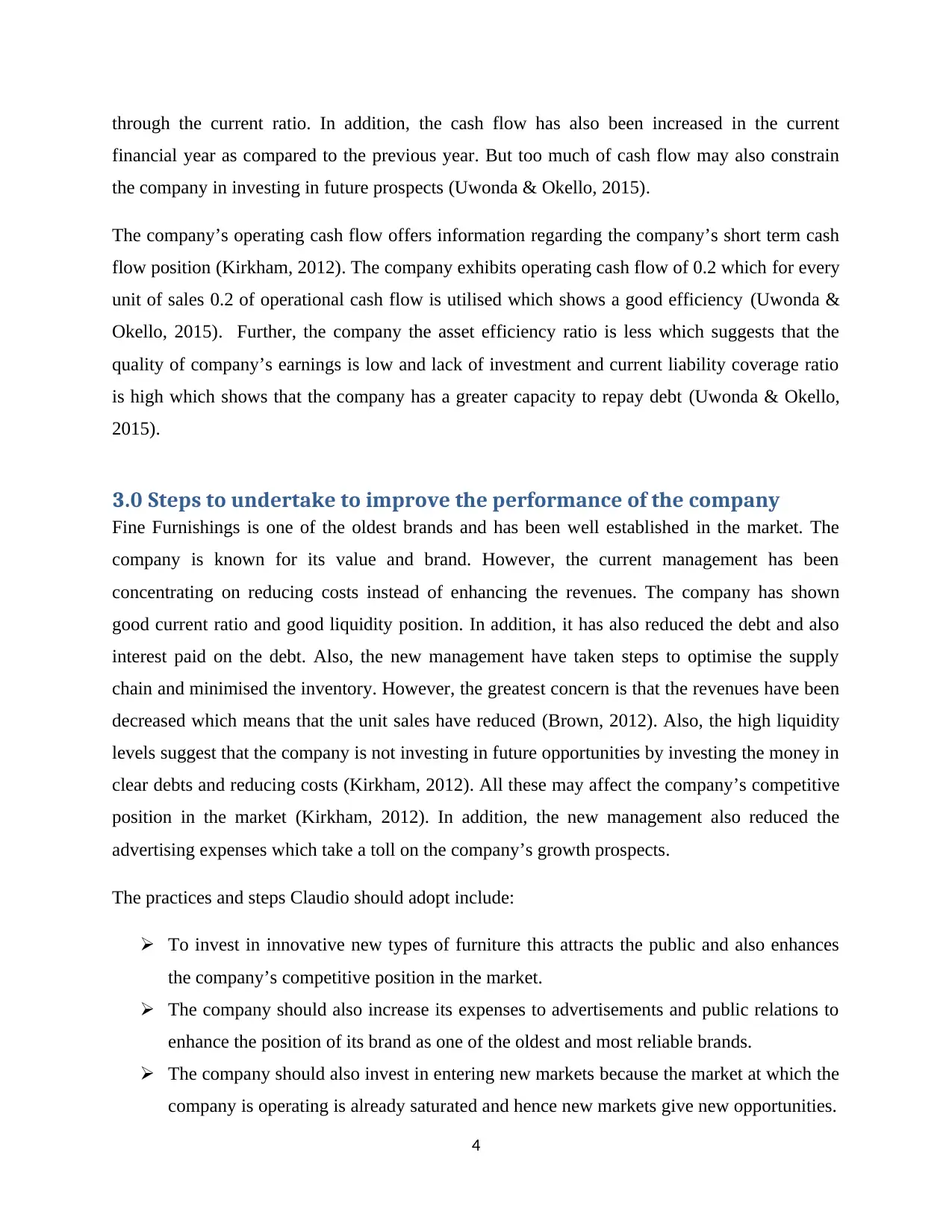
through the current ratio. In addition, the cash flow has also been increased in the current
financial year as compared to the previous year. But too much of cash flow may also constrain
the company in investing in future prospects (Uwonda & Okello, 2015).
The company’s operating cash flow offers information regarding the company’s short term cash
flow position (Kirkham, 2012). The company exhibits operating cash flow of 0.2 which for every
unit of sales 0.2 of operational cash flow is utilised which shows a good efficiency (Uwonda &
Okello, 2015). Further, the company the asset efficiency ratio is less which suggests that the
quality of company’s earnings is low and lack of investment and current liability coverage ratio
is high which shows that the company has a greater capacity to repay debt (Uwonda & Okello,
2015).
3.0 Steps to undertake to improve the performance of the company
Fine Furnishings is one of the oldest brands and has been well established in the market. The
company is known for its value and brand. However, the current management has been
concentrating on reducing costs instead of enhancing the revenues. The company has shown
good current ratio and good liquidity position. In addition, it has also reduced the debt and also
interest paid on the debt. Also, the new management have taken steps to optimise the supply
chain and minimised the inventory. However, the greatest concern is that the revenues have been
decreased which means that the unit sales have reduced (Brown, 2012). Also, the high liquidity
levels suggest that the company is not investing in future opportunities by investing the money in
clear debts and reducing costs (Kirkham, 2012). All these may affect the company’s competitive
position in the market (Kirkham, 2012). In addition, the new management also reduced the
advertising expenses which take a toll on the company’s growth prospects.
The practices and steps Claudio should adopt include:
To invest in innovative new types of furniture this attracts the public and also enhances
the company’s competitive position in the market.
The company should also increase its expenses to advertisements and public relations to
enhance the position of its brand as one of the oldest and most reliable brands.
The company should also invest in entering new markets because the market at which the
company is operating is already saturated and hence new markets give new opportunities.
4
financial year as compared to the previous year. But too much of cash flow may also constrain
the company in investing in future prospects (Uwonda & Okello, 2015).
The company’s operating cash flow offers information regarding the company’s short term cash
flow position (Kirkham, 2012). The company exhibits operating cash flow of 0.2 which for every
unit of sales 0.2 of operational cash flow is utilised which shows a good efficiency (Uwonda &
Okello, 2015). Further, the company the asset efficiency ratio is less which suggests that the
quality of company’s earnings is low and lack of investment and current liability coverage ratio
is high which shows that the company has a greater capacity to repay debt (Uwonda & Okello,
2015).
3.0 Steps to undertake to improve the performance of the company
Fine Furnishings is one of the oldest brands and has been well established in the market. The
company is known for its value and brand. However, the current management has been
concentrating on reducing costs instead of enhancing the revenues. The company has shown
good current ratio and good liquidity position. In addition, it has also reduced the debt and also
interest paid on the debt. Also, the new management have taken steps to optimise the supply
chain and minimised the inventory. However, the greatest concern is that the revenues have been
decreased which means that the unit sales have reduced (Brown, 2012). Also, the high liquidity
levels suggest that the company is not investing in future opportunities by investing the money in
clear debts and reducing costs (Kirkham, 2012). All these may affect the company’s competitive
position in the market (Kirkham, 2012). In addition, the new management also reduced the
advertising expenses which take a toll on the company’s growth prospects.
The practices and steps Claudio should adopt include:
To invest in innovative new types of furniture this attracts the public and also enhances
the company’s competitive position in the market.
The company should also increase its expenses to advertisements and public relations to
enhance the position of its brand as one of the oldest and most reliable brands.
The company should also invest in entering new markets because the market at which the
company is operating is already saturated and hence new markets give new opportunities.
4
Paraphrase This Document
Need a fresh take? Get an instant paraphrase of this document with our AI Paraphraser
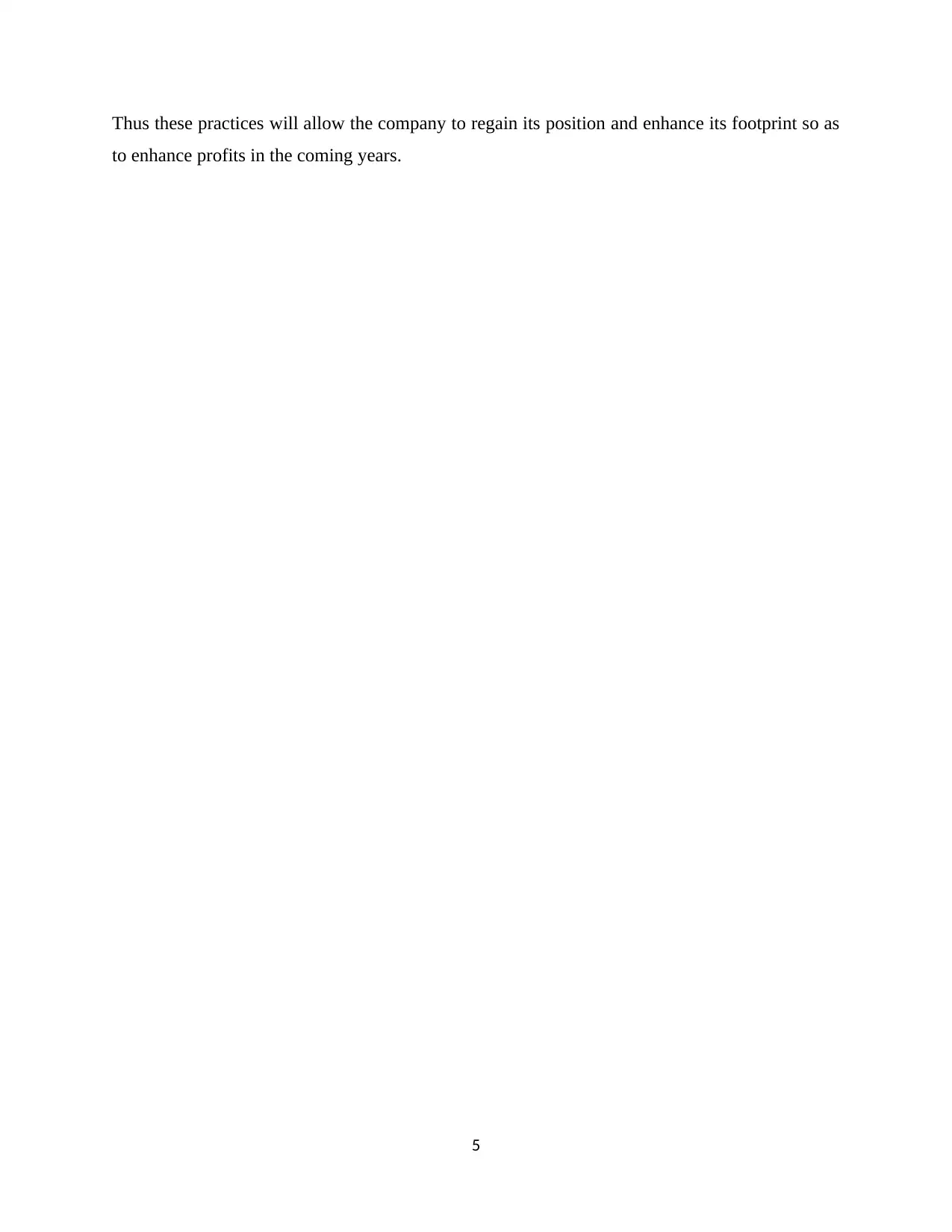
Thus these practices will allow the company to regain its position and enhance its footprint so as
to enhance profits in the coming years.
5
to enhance profits in the coming years.
5
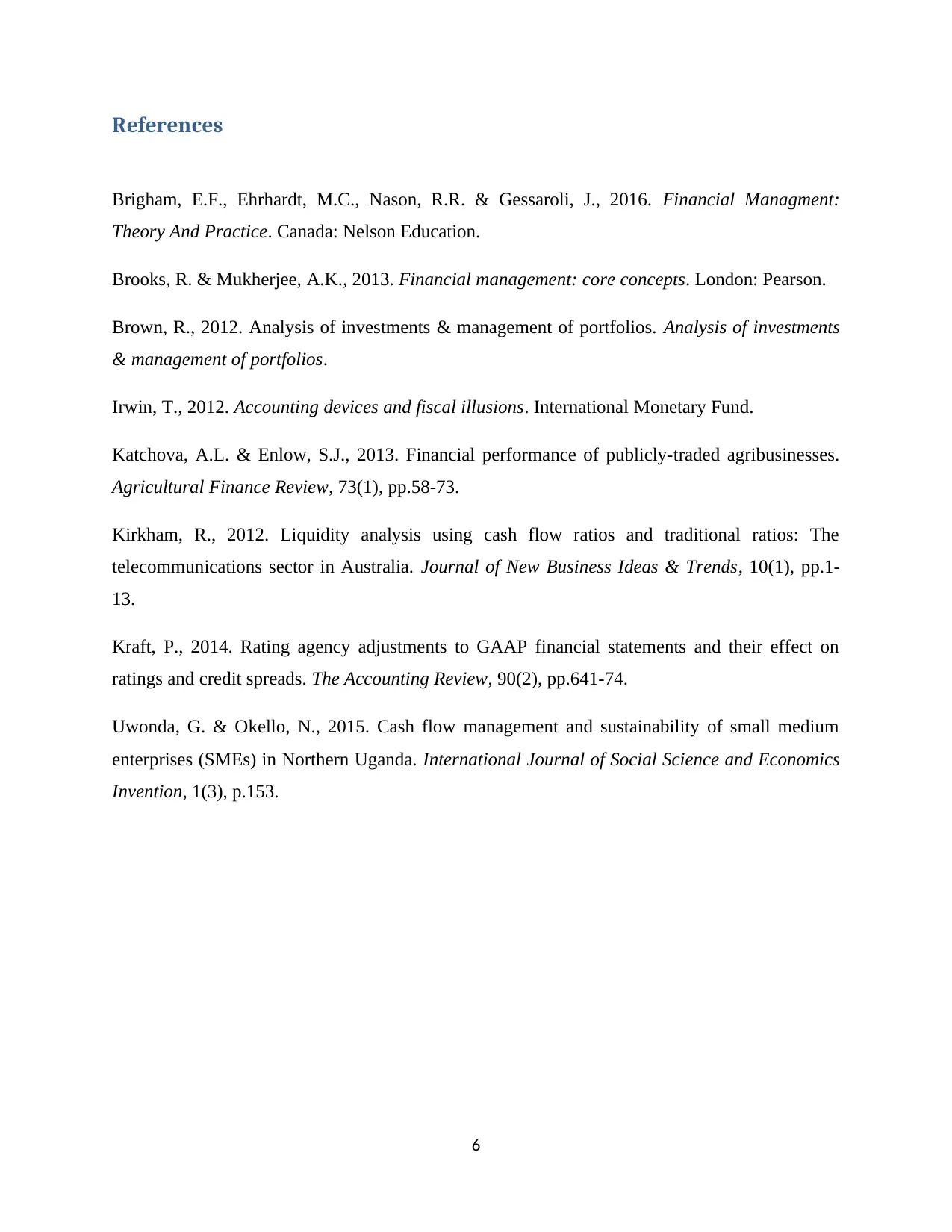
References
Brigham, E.F., Ehrhardt, M.C., Nason, R.R. & Gessaroli, J., 2016. Financial Managment:
Theory And Practice. Canada: Nelson Education.
Brooks, R. & Mukherjee, A.K., 2013. Financial management: core concepts. London: Pearson.
Brown, R., 2012. Analysis of investments & management of portfolios. Analysis of investments
& management of portfolios.
Irwin, T., 2012. Accounting devices and fiscal illusions. International Monetary Fund.
Katchova, A.L. & Enlow, S.J., 2013. Financial performance of publicly-traded agribusinesses.
Agricultural Finance Review, 73(1), pp.58-73.
Kirkham, R., 2012. Liquidity analysis using cash flow ratios and traditional ratios: The
telecommunications sector in Australia. Journal of New Business Ideas & Trends, 10(1), pp.1-
13.
Kraft, P., 2014. Rating agency adjustments to GAAP financial statements and their effect on
ratings and credit spreads. The Accounting Review, 90(2), pp.641-74.
Uwonda, G. & Okello, N., 2015. Cash flow management and sustainability of small medium
enterprises (SMEs) in Northern Uganda. International Journal of Social Science and Economics
Invention, 1(3), p.153.
6
Brigham, E.F., Ehrhardt, M.C., Nason, R.R. & Gessaroli, J., 2016. Financial Managment:
Theory And Practice. Canada: Nelson Education.
Brooks, R. & Mukherjee, A.K., 2013. Financial management: core concepts. London: Pearson.
Brown, R., 2012. Analysis of investments & management of portfolios. Analysis of investments
& management of portfolios.
Irwin, T., 2012. Accounting devices and fiscal illusions. International Monetary Fund.
Katchova, A.L. & Enlow, S.J., 2013. Financial performance of publicly-traded agribusinesses.
Agricultural Finance Review, 73(1), pp.58-73.
Kirkham, R., 2012. Liquidity analysis using cash flow ratios and traditional ratios: The
telecommunications sector in Australia. Journal of New Business Ideas & Trends, 10(1), pp.1-
13.
Kraft, P., 2014. Rating agency adjustments to GAAP financial statements and their effect on
ratings and credit spreads. The Accounting Review, 90(2), pp.641-74.
Uwonda, G. & Okello, N., 2015. Cash flow management and sustainability of small medium
enterprises (SMEs) in Northern Uganda. International Journal of Social Science and Economics
Invention, 1(3), p.153.
6
⊘ This is a preview!⊘
Do you want full access?
Subscribe today to unlock all pages.

Trusted by 1+ million students worldwide
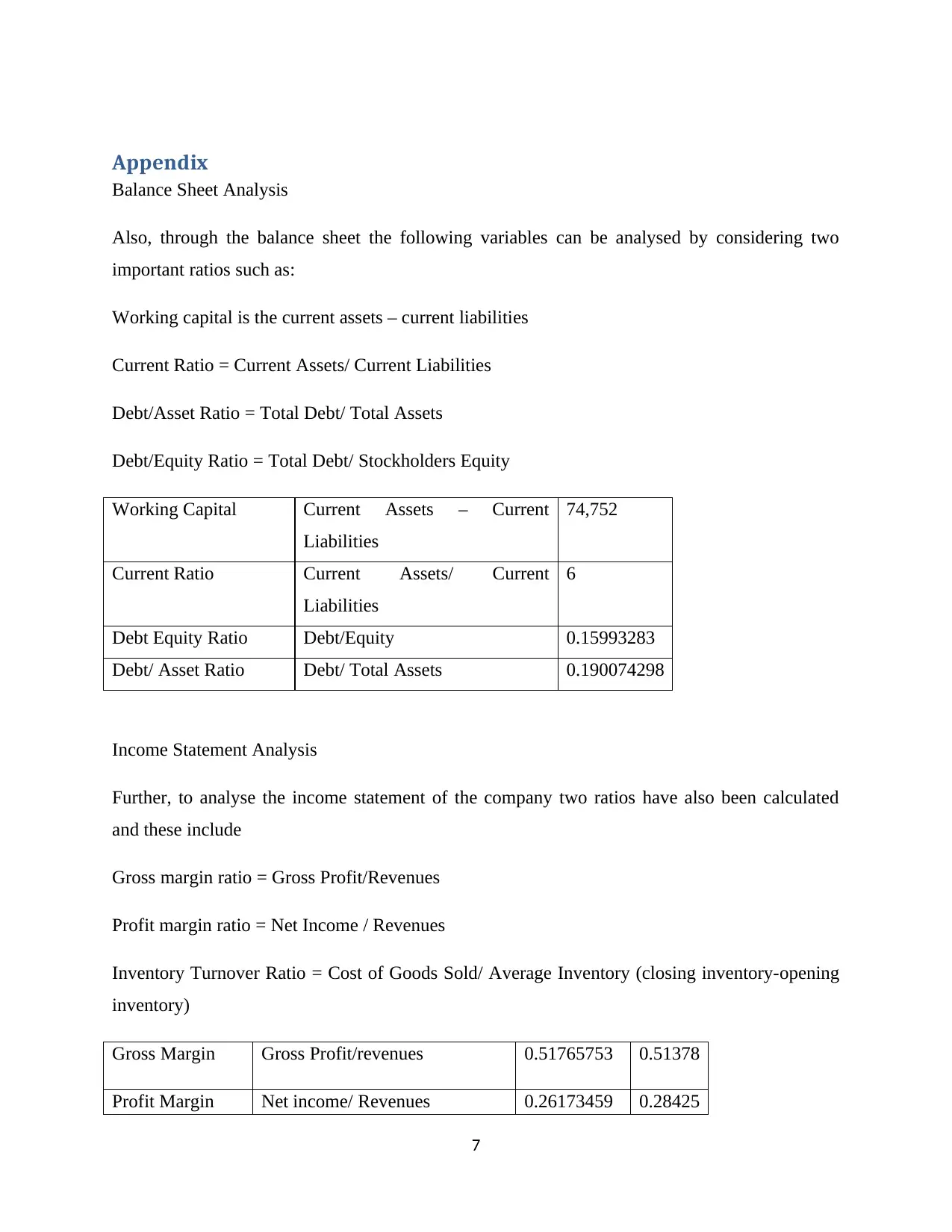
Appendix
Balance Sheet Analysis
Also, through the balance sheet the following variables can be analysed by considering two
important ratios such as:
Working capital is the current assets – current liabilities
Current Ratio = Current Assets/ Current Liabilities
Debt/Asset Ratio = Total Debt/ Total Assets
Debt/Equity Ratio = Total Debt/ Stockholders Equity
Working Capital Current Assets – Current
Liabilities
74,752
Current Ratio Current Assets/ Current
Liabilities
6
Debt Equity Ratio Debt/Equity 0.15993283
Debt/ Asset Ratio Debt/ Total Assets 0.190074298
Income Statement Analysis
Further, to analyse the income statement of the company two ratios have also been calculated
and these include
Gross margin ratio = Gross Profit/Revenues
Profit margin ratio = Net Income / Revenues
Inventory Turnover Ratio = Cost of Goods Sold/ Average Inventory (closing inventory-opening
inventory)
Gross Margin Gross Profit/revenues 0.51765753 0.51378
Profit Margin Net income/ Revenues 0.26173459 0.28425
7
Balance Sheet Analysis
Also, through the balance sheet the following variables can be analysed by considering two
important ratios such as:
Working capital is the current assets – current liabilities
Current Ratio = Current Assets/ Current Liabilities
Debt/Asset Ratio = Total Debt/ Total Assets
Debt/Equity Ratio = Total Debt/ Stockholders Equity
Working Capital Current Assets – Current
Liabilities
74,752
Current Ratio Current Assets/ Current
Liabilities
6
Debt Equity Ratio Debt/Equity 0.15993283
Debt/ Asset Ratio Debt/ Total Assets 0.190074298
Income Statement Analysis
Further, to analyse the income statement of the company two ratios have also been calculated
and these include
Gross margin ratio = Gross Profit/Revenues
Profit margin ratio = Net Income / Revenues
Inventory Turnover Ratio = Cost of Goods Sold/ Average Inventory (closing inventory-opening
inventory)
Gross Margin Gross Profit/revenues 0.51765753 0.51378
Profit Margin Net income/ Revenues 0.26173459 0.28425
7
Paraphrase This Document
Need a fresh take? Get an instant paraphrase of this document with our AI Paraphraser
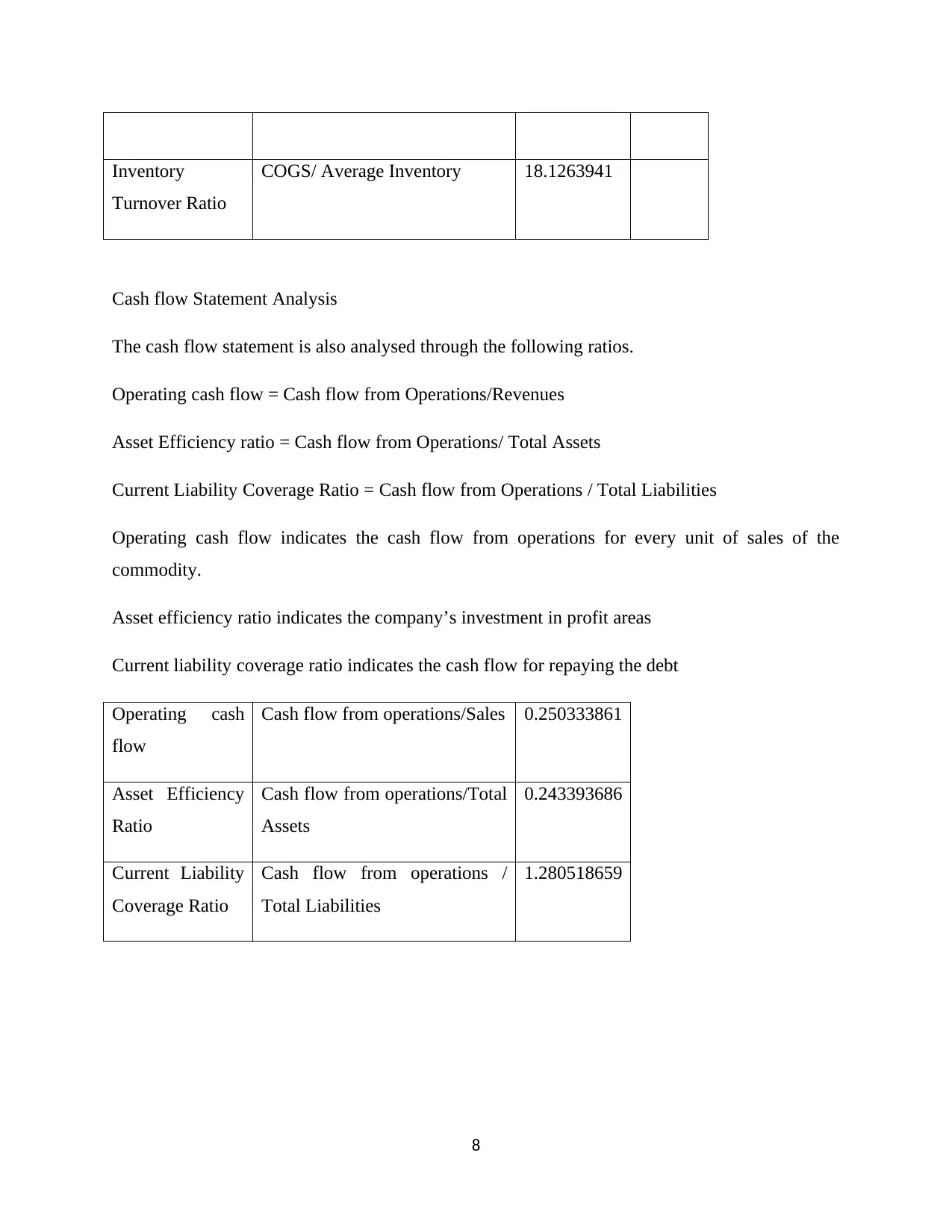
Inventory
Turnover Ratio
COGS/ Average Inventory 18.1263941
Cash flow Statement Analysis
The cash flow statement is also analysed through the following ratios.
Operating cash flow = Cash flow from Operations/Revenues
Asset Efficiency ratio = Cash flow from Operations/ Total Assets
Current Liability Coverage Ratio = Cash flow from Operations / Total Liabilities
Operating cash flow indicates the cash flow from operations for every unit of sales of the
commodity.
Asset efficiency ratio indicates the company’s investment in profit areas
Current liability coverage ratio indicates the cash flow for repaying the debt
Operating cash
flow
Cash flow from operations/Sales 0.250333861
Asset Efficiency
Ratio
Cash flow from operations/Total
Assets
0.243393686
Current Liability
Coverage Ratio
Cash flow from operations /
Total Liabilities
1.280518659
8
Turnover Ratio
COGS/ Average Inventory 18.1263941
Cash flow Statement Analysis
The cash flow statement is also analysed through the following ratios.
Operating cash flow = Cash flow from Operations/Revenues
Asset Efficiency ratio = Cash flow from Operations/ Total Assets
Current Liability Coverage Ratio = Cash flow from Operations / Total Liabilities
Operating cash flow indicates the cash flow from operations for every unit of sales of the
commodity.
Asset efficiency ratio indicates the company’s investment in profit areas
Current liability coverage ratio indicates the cash flow for repaying the debt
Operating cash
flow
Cash flow from operations/Sales 0.250333861
Asset Efficiency
Ratio
Cash flow from operations/Total
Assets
0.243393686
Current Liability
Coverage Ratio
Cash flow from operations /
Total Liabilities
1.280518659
8
1 out of 8
Related Documents
Your All-in-One AI-Powered Toolkit for Academic Success.
+13062052269
info@desklib.com
Available 24*7 on WhatsApp / Email
![[object Object]](/_next/static/media/star-bottom.7253800d.svg)
Unlock your academic potential
Copyright © 2020–2025 A2Z Services. All Rights Reserved. Developed and managed by ZUCOL.





